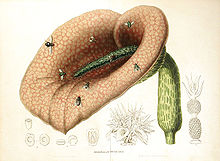Dead-horse arum
| Dead horse arum lily | |
|---|---|
 |
|
| Illustration from Louis van Houtte's Flore des serres et des jardins de l'Europe (1849) | |
| Scientific classification | |
| Kingdom: | Plantae |
| (unranked): | Angiosperms |
| (unranked): | Monocots |
| Order: | Alismatales |
| Family: | Araceae |
| Subfamily: | Aroideae |
| Tribe: | Areae |
| Genus: |
Helicodiceros Schott |
| Species: | H. muscivorus |
| Binomial name | |
|
Helicodiceros muscivorus (L.f.) Engl. |
|
 |
|
| Range of Helicodiceros muscivorus in Europe | |
| Synonyms | |
|
|
Helicodiceros muscivorus (dead horse arum lily) is an ornamental plant native to Corsica, Sardinia and the Balearic Islands. It is the only species in the genus Helicodiceros. Within the Araceae family the plant is part of the Aroideae subfamily.
The flowers of H. muscivorus smell like rotting meat, attracting carrion-seeking blow flies which act as pollinators. One of a rare group of thermogenic plants, the dead horse arum can raise its temperature by thermogenesis. This helps to lure flies into the plant to contact its pollen. The plant still is being studied for the way it is able to produce its own heat without being necessarily dependent of ambient temperature.
The inflorescence of the arum lilies is a three-part spadix which resembles the anal area of a dead mammal. In between is a hairy spathe such as a ‘tail’ running down into the chamber of the flower which bonds with the fertile male and female florets. The appendix and the male florets are thermogenic, but have different temporal patterns. The exits of the female florets are hindered by spines and filaments which serve to trap the blow flies once inside. The male florets exhibit independence from the ambient temperatures as heat production depends on the time of the day rather than ambient temperatures. Also, uncoupling protein was found in both the thermogenic male florets and the appendix. The protein is 1178 nucleotides in length in the dead horse arum mRNA excluding the poly-A tail and it is believed to have a protein of 304 amino acids. It also possesses three mitochondrial carrier signature domains, six membrane-spanning domains, and one nucleotide-binding domain. Potato and rice have been compared to the plant at times due to its typical features of the uncoupling protein. Uncoupling protein plays a role in the production of energy to become heat.
...
Wikipedia
